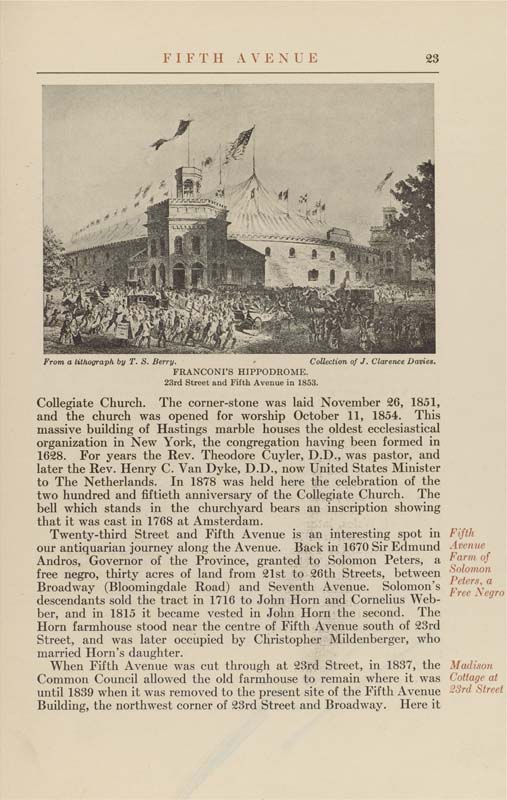FIFTH AVENUE
23
From a lithograph hy T. S. Berry.
Collection of J. Clarence Davies.
FRANCONI'S HIPPODROME.
23rd Street and Fifth Avenue in 1853.
Collegiate Church. The corner-stone was laid November 26, 1851,
and the church was opened for worship October 11, 1854. This
massive building of Hastings marble houses the oldest ecclesiastical
organization in New York, the congregation having been formed in
1628. For years the Rev. Theodore Cuyler, D.D., was pastor, and
later the Rev. Henry C. Van Dyke, D.D., now United States Minister
to The Netherlands. In 1878 was held here the celebration of the
two hundred and fiftieth anniversary of the Collegiate Church. The
bell which stands in the churchyard bears an inscription showing
that it was cast in 1768 at Amsterdam.
Twenty-third Street and Fifth Avenue is an interesting spot in
our antiquarian journey along the Avenue. Back in 1670 Sir Edmund
Andros, Governor of the Province, granted to Solomon Peters, a
free negro, thirty acres of land from 21st to 26th Streets, between
Broadway (Bloomingdale Road) and Seventh Avenue. Solomon's
descendants sold the tract in 1716 to John Horn and Cornelius Web¬
ber, and in 1815 it became vested in John Horn the second. The
Horn farmhouse stood near the centre of Fifth Avenue south of 23rd
Street, and was later occupied by Christopher Mildenberger, who
married Horn's daughter.
When Fifth Avenue was cut through at 23rd Street, in 1837, the
Common Council allowed the old farmhouse to remain where it was
until 1839 when it was removed to the present site of the Fifth Avenue
Building, the northwest corner of 23rd Street and Broadway. Here it
Fifth
Avenue
Farm of
Solomon
Peters, a
Free Negro
Madison
Cottage at
23rd Street
|








